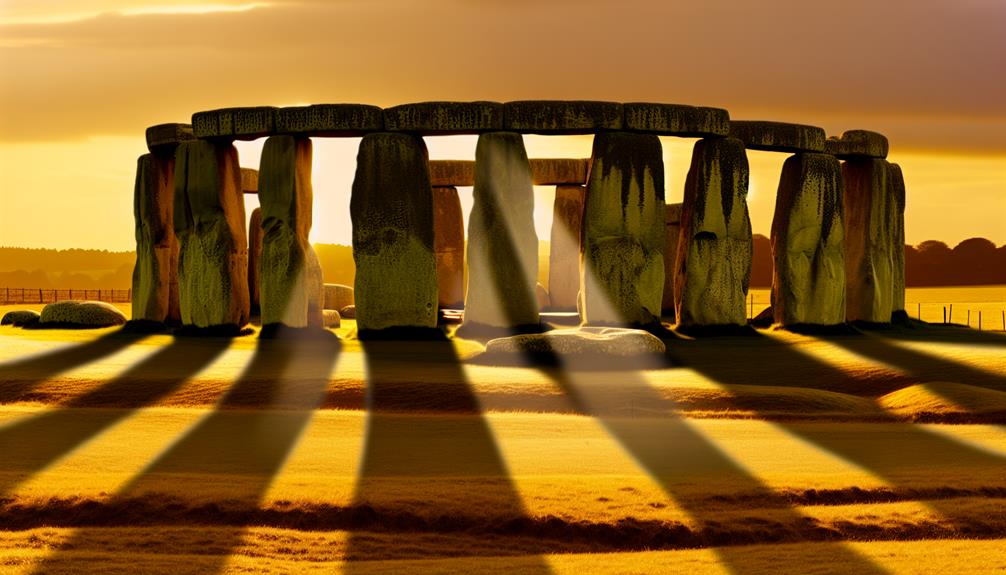Stonehenge, a UNESCO World Heritage Site in the UK, stands as a tribute to the ancient ingenuity of its builders. The enigmatic monument's massive stones, meticulously arranged in concentric patterns, have puzzled historians and archeologists for centuries. Theories regarding its purpose range from celestial observatory to burial ground, sparking ongoing debates and research. While some mysteries surrounding Stonehenge have been unraveled, many questions remain unanswered, inviting further exploration into the secrets that this ancient site holds.
Key Takeaways
- Stonehenge built around 3000 BC by ancient civilizations.
- Purpose includes rituals, astronomy, and possibly as a burial ground.
- Megalithic stones weigh up to 25 tons, arranged symbolically.
- Alignments with solstices and equinoxes showcase astronomical significance.
- Conservation efforts preserve site, offer interactive exhibits, and manage visitors effectively.
Stonehenge's History and Origins
Why did ancient civilizations build Stonehenge, and what are the origins of this enigmatic monument in the UK? Stonehenge stands as a testament to the ingenuity and architectural prowess of ancient peoples, sparking both fascination and mystery. The origins of Stonehenge date back to around 3000 BC, with its construction believed to have occurred in several phases. While the exact purpose of Stonehenge remains a subject of debate among scholars, many theories suggest it was used for ancient rituals, astronomical observations, and as a burial ground.
The mystery surrounding Stonehenge's origins adds to its allure, inviting exploration and prompting researchers to investigate further into its history. The monument's alignment with the solstices and equinoxes indicates a possible connection to celestial events and the changing seasons, leading to theories that Stonehenge served as a primitive calendar or a place of worship for sun worshipers.
Ancient rituals are thought to have played a significant role in the construction and use of Stonehenge. The precise arrangement of the massive stones, some weighing up to 50 tons, suggests careful planning and a deep understanding of astronomy and geometry. The site's layout and design point to a structured society with a complex belief system that placed importance on the cycles of nature and the cosmos.
Significance of the Megalithic Stones
The megalithic stones at Stonehenge, towering and meticulously placed, hold profound significance in understanding the architectural and cultural achievements of ancient civilizations. These massive stones, some reaching up to 30 feet in height and weighing up to 25 tons, have sparked numerous symbolic interpretations and have been the subject of extensive archaeological discoveries.
Archaeological excavations around Stonehenge have revealed that the megaliths were transported from long distances, showcasing the engineering capabilities of the prehistoric people who constructed this monument. The precision with which the stones were positioned suggests advanced knowledge of astronomy and geometry, leading to theories that Stonehenge could have served as an astronomical observatory or a ceremonial site aligned with celestial events.
Furthermore, the arrangement of the stones into concentric circles and horseshoe shapes has led to speculation about the symbolic meanings behind these formations. Some researchers believe that the circular shape represents the cycle of life and death, while others suggest that the horseshoe shapes could have been associated with rituals or worship practices.
Theories on Stonehenge's Purpose
One of the enduring enigmas surrounding Stonehenge pertains to its purpose, a subject that has fueled a plethora of scholarly debates and conjectures throughout the centuries. Scholars have proposed various theories regarding the function of this ancient monument, with two prominent suggestions being its use in ritual ceremonies and astronomical observations.
Theories on Stonehenge's Purpose
To shed light on the possible purposes of Stonehenge, let's explore the two main theories:
| Theory | Description | Supporting Evidence |
|---|---|---|
| Ritual Ceremonies | Many believe Stonehenge was a site for religious or spiritual ceremonies. The alignment of the stones with celestial events might have been vital in these rituals. | – Human remains found near Stonehenge suggest burial rituals.<br>- Altar-like structures hint at ceremonies. |
| Astronomical Observations | Another theory posits that Stonehenge served as an observatory to track celestial events like solstices and equinoxes. Its layout could have facilitated such observations. | – Alignment of certain stones with astronomical events.<br>- The Heel Stone marking the sunrise on the summer solstice. |
These theories provide compelling insights into the possible functions of Stonehenge, yet the mystery remains unsolved. The intricate design and alignment of the stones continue to intrigue researchers, inviting further exploration and analysis into the ancient site's true purpose.
Alignments With Solstices and Equinoxes
Amidst the ongoing debate over Stonehenge's purpose, a significant aspect that captivates researchers is its precise alignments with solstices and equinoxes, hinting at a possible astronomical connection. The layout of Stonehenge, with its massive standing stones and carefully positioned lintels, seems to have been intentionally designed to align with the movements of the sun during the solstices and equinoxes.
Astronomical observations suggest that during the summer solstice, the rising sun aligns perfectly with the Heel Stone and the Altar Stone, illuminating the central axis of the monument. This alignment indicates a deep understanding of the solar cycle and showcases the importance of celestial events in ancient cultures. Similarly, during the winter solstice, the sun sets in line with the stones, creating a mesmerizing spectacle that would have held great significance for the people who constructed Stonehenge.
Archaeological findings support the theory that these alignments were not merely coincidental but were intentionally incorporated into the design of Stonehenge. The precision with which the stones were placed highlights the advanced knowledge of astronomy possessed by the ancient builders. These alignments likely played a significant role in ancient rituals and ceremonies, marking important dates in the agricultural or religious calendar. Stonehenge's connection to solstices and equinoxes serves as an affirmation to the cultural interpretations of celestial events in prehistoric societies.
Construction Techniques and Tools Used
Utilizing sophisticated methods and specialized tools, the construction of Stonehenge exemplifies a remarkable feat of ancient engineering prowess. The ancient builders employed a combination of innovative techniques and advanced tools to transport, shape, and erect the massive stones that make up this iconic monument.
One of the most intriguing aspects of Stonehenge's construction is the precise shaping of the stones, which were dressed using primitive tools like antler picks and bone hammers. This meticulous craftsmanship guaranteed that the stones fit together seamlessly to create the intricate architectural design that has stood the test of time.
In addition to the shaping of the stones, the transportation of these massive blocks remains a subject of fascination and debate among archaeologists. Recent research suggests that the builders may have used a system of sledges, wooden rollers, and possibly ropes to move the stones over long distances from quarries to the Stonehenge site. This highlights the ingenuity and resourcefulness of the ancient engineers who designed and executed such a complex construction project using rudimentary tools and methods.
The construction of Stonehenge stands as a confirmation to the creativity and skill of our ancient ancestors, showcasing their ability to harness the natural environment and innovate with the tools at their disposal. By studying the ancient methods and innovative tools used in building Stonehenge, we gain valuable insights into the technological capabilities and architectural achievements of prehistoric societies.
Preservation Efforts and Visitor Experience
In the domain of preserving historical integrity and enhancing visitor engagement, the ongoing efforts at Stonehenge exemplify a meticulous balance between conservation and immersive experience design. The preservation challenges faced at Stonehenge are met with innovative solutions to guarantee the ancient site's longevity while providing an enriching experience for visitors.
Here are four key aspects that highlight the preservation efforts and visitor experience at Stonehenge:
- Conservation Techniques: Stonehenge faces weathering effects and structural instability due to its age and exposure to the elements. Conservation experts employ cutting-edge methods to stabilize the stones, prevent erosion, and safeguard the site from environmental damage.
- Interactive Exhibits: To enhance visitor satisfaction, interactive exhibits have been strategically placed around Stonehenge. These exhibits offer insights into the monument's history, construction, and significance, allowing visitors to engage with the site on a deeper level.
- Visitor Management: Managing the flow of visitors is essential to preserving the site and ensuring a positive experience for all. Advanced ticketing systems, guided tours, and designated viewing areas help regulate foot traffic and minimize impact on the monument.
- Educational Programs: Stonehenge offers a range of educational programs aimed at enriching the visitor experience. From lectures by archaeologists to hands-on workshops, these programs cater to diverse interests and provide a deeper understanding of Stonehenge's cultural importance.
Stonehenge's Ongoing Mysteries
Investigating the enigmatic charm of Stonehenge reveals a multitude of mysteries that persist in intriguing historians, archaeologists, and visitors alike. One of the ongoing mysteries surrounding Stonehenge is the purpose behind its construction. While some theories suggest it was a burial ground, others propose it was a site for sacred rituals or astronomical observations. The alignment of the stones with the solstices and other celestial events adds to the intrigue, leading to speculations about the role of Stonehenge in ancient societies.
Another enigma that continues to puzzle experts is how the massive stones, some weighing up to 25 tons, were transported over long distances and erected with such precision using rudimentary tools. The sheer engineering prowess required for such a feat during the Neolithic period raises questions about the societal organization and technological capabilities of the builders.
Furthermore, the significance of the surrounding landscape and the presence of burial mounds and other ancient structures in the vicinity add layers to the mystery of Stonehenge. The interplay between these elements suggests a complex cultural and religious landscape that is yet to be fully understood. As researchers explore further into the site's history, the enigmatic allure of Stonehenge only grows, beckoning investigation and interpretation of its secrets.
Frequently Asked Questions
How Were the Stones Transported to Stonehenge?
Methods and theories surrounding the transportation of stones have intrigued scholars for centuries. Various hypotheses propose methods such as sledges, rollers, rafts, and even a combination of these techniques.
Theories suggest that a workforce of laborers may have been involved in moving these massive stones over long distances. The exact method used remains a subject of debate and further research to uncover the most plausible explanation for this monumental feat.
Are There Any Hidden Chambers or Tunnels at Stonehenge?
Hidden chambers and tunnels have long fascinated archaeologists, offering the promise of revealing ancient mysteries. Recent archaeological discoveries in various locations have unveiled the existence of such structures, shedding light on the complexities of past civilizations.
These hidden compartments provide valuable insights into the daily lives, beliefs, and practices of our ancestors, showcasing the ingenuity and sophistication of ancient societies in their construction and design.
Can Visitors Touch the Stones at Stonehenge?
Visitors are not allowed to touch the stones at Stonehenge as part of the site's preservation efforts. Stonehenge rules strictly prohibit physical contact with the ancient stones to prevent damage and maintain the historical integrity of the monument.
This policy is essential in ensuring that future generations can also experience the awe-inspiring wonder of Stonehenge in its authentic form, safeguarding its cultural significance for years to come.
What Is the Significance of the Surrounding Landscape?
The importance of the surrounding landscape in archaeological sites often lies in its landscape symbolism and its connection to astronomical alignment.
Through excavations, researchers uncover Neolithic settlements that further deepen our understanding of ancient civilizations.
The landscape serves as a vital backdrop for these discoveries, offering clues about how our ancestors interacted with their environment and the cosmos.
Studying the relationship between ancient sites and their surroundings sheds light on the cultural and historical significance of these places.
Are There Any Ancient Artifacts Found Near Stonehenge?
Ancient relics hold profound insights into past civilizations, shedding light on their customs and beliefs. Through archaeological discoveries, a rich tapestry of history unfolds, revealing the intricate connections between societies and their environments.
Near certain sites of historical significance, such as Stonehenge, UK, ancient artifacts have been unearthed, providing glimpses into the lives of our ancestors. These relics serve as tangible links to our past, offering a glimpse into the mysteries of bygone eras.
Conclusion
To sum up, Stonehenge stands as a marvel of ancient engineering and astronomical knowledge, showcasing the ingenuity of its creators. Its megalithic stones, precise alignments with celestial events, and intricate design continue to mystify researchers and visitors alike.
The preservation efforts and interactive exhibits enhance the experience, allowing for a deeper appreciation of our ancient past. Stonehenge's enigmatic purpose and construction techniques underscore its enduring significance as a proof of human achievement. Its mysteries remain a fascinating enigma for generations to come.


